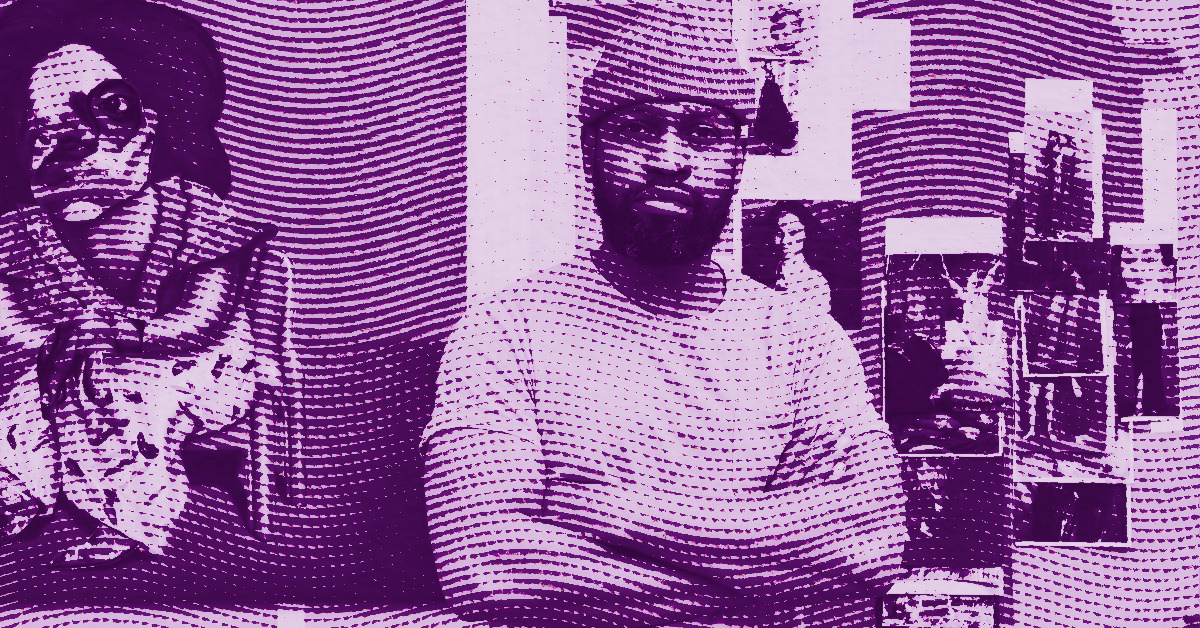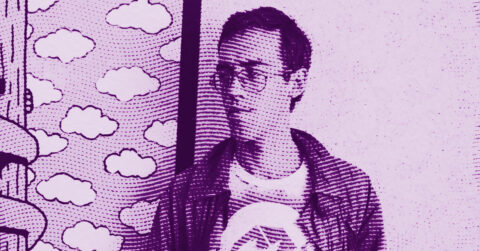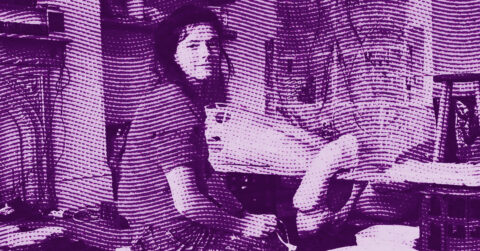Listen to me carefully, you bunch of snobs: Nathaniel Mary Quinn is not only a painter who breaks faces, he is an architect of the human soul who builds his cathedrals on the ruins of our visual certainties. For more than a decade, this Brooklyn artist born in 1977 in Chicago’s Robert Taylor Homes has disrupted our conception of contemporary portraiture with a virtuosity that confounds as much as it delights. His works, true symphonies of charcoal, oil, and pastel, confront us with a disturbing truth: we are not the coherent beings we claim to be, but precarious assemblies of memories, traumas, and aspirations.
Quinn’s work flourishes in this fertile tension between destruction and reconstruction, between the legacy of synthetic cubism and a deeply contemporary sensibility. His composite portraits, which might mistakenly be taken for collages, are entirely hand-painted using a technique that amounts to visual alchemy. The artist draws his fragments from fashion magazines, family photographs, and images found on the internet, recomposing them into faces that seem to emerge from the depths of the collective unconscious.
This aesthetic of fragmentation does not arise by chance, but from a biography marked by abandonment and loss. When Quinn, then fifteen years old, discovers the family apartment empty upon returning from his Thanksgiving vacation, after the death of his mother Mary, he experiences the brutal rupture of existential discontinuity. This foundational break now infuses his art with productive melancholy, transforming personal trauma into a universal pictorial language.
The Architecture of Memory
Quinn’s approach reveals deep affinities with contemporary architectural concerns, particularly those questioning the relationship between space, memory, and identity. Like architect Peter Eisenman in his deconstructivist projects, Quinn questions the idea of a stable and unified structure [1]. His shattered faces evoke Eisenman’s fragmented spaces, where Euclidean geometry gives way to a more complex logic, that of temporal superposition and perspectival multiplicity.
This architectural analogy is enriched when considering how Quinn literally constructs his compositions. The artist proceeds by layering, each painted fragment constituting an architectural element of the reconstructed identity. Eyes, noses, mouths, and other physiognomic elements function as prefabricated modules that he assembles according to a logic that goes beyond mere photographic resemblance. This modular approach recalls the theories of Japanese architect Kisho Kurokawa on architectural metabolism, where buildings are designed as evolving organisms capable of integrating new elements without losing their overall coherence.
Temporality plays a central role in this architecture of memory. Quinn does not depict his subjects at a given moment, but captures them in their temporal thickness, an accumulation of all the instances that have constructed them. This layered approach evokes urban testimonies where the traces of successive civilizations can be read. His portraits thus become archaeological sites of identity, where each painted fragment reveals a different stratum of the subject’s existence.
The use of color also participates in this architectural logic. Quinn employs muted tones, browns, ochres, and faded pinks, which evoke raw building materials: concrete, terracotta, oxidized metal. These chromatic choices anchor his works in a materiality that goes beyond pure representation to reach a sculptural dimension. The faces seem constructed rather than painted, built stone by stone like monuments to human complexity.
This architectural dimension reaches its peak in large-format works like “Apple of Her Eye” (2019), where the male face unfolds like a monumental facade. The composition plays with scales, some oversized elements creating impossible perspective effects that disorient the viewer. This manipulation of scale, characteristic of contemporary architecture, transforms the act of looking into an immersive spatial experience.
The influence of deconstructivist architecture also manifests in the way Quinn treats the negative spaces of his compositions. Far from being mere backgrounds, these areas actively participate in the construction of meaning, creating breaths that allow the painted fragments to resonate with each other. This attention to emptiness recalls the concerns of architects like Tadao Ando, for whom the non-built space is as important as the built space.
The “SCENES” (2022) series pushes this architectural logic toward new territories by integrating references to cinematic iconography. Film and television series characters become inhabitants of these psychic architectures, occupying the pictorial space like figures in a set. This theatrical dimension reinforces the analogy with architecture, the work becoming a place of representation where the dramas of contemporary identity are played out.
The Opera of Psychic Interior
If architecture provides Quinn with his formal vocabulary, one must turn to lyrical art to understand the emotional dimension of his work. His portraits function as visual arias where each painted fragment constitutes a note in a complex score dedicated to the exploration of human interiority. This operatic approach is not a metaphor but a true structural correspondence between musical construction and pictorial construction.
Opera, the art of synthesis par excellence, combines music, theater, poetry, and visual arts to create a total experience. Quinn performs a similar synthesis by merging in his portraits elements from heterogeneous visual registers: fashion photography, popular imagery, family memories, artistic references. This constant hybridization creates a visual polyphony that evokes the complex choirs of grand romantic operas.
Wagner’s dramaturgy finds a particular echo in Quinn’s work. Just as Wagner built his operas around musical leitmotifs that transform and combine throughout the work, Quinn develops recurring visual motifs, full lips, misaligned eyes, and fragmented noses, which form his aesthetic signature. These elements function like pictorial leitmotifs that allow his work to be read as a unified cycle dedicated to exploring the human condition.
The emotional intensity of Verdi’s operas also nourishes Quinn’s art. His portraits capture their subjects in moments of maximal psychological tension, like Verdi’s characters seized at the climax of their aria. “That Moment with Mr. Laws” (2019) perfectly illustrates this aesthetic of intensity: the male face, in raw colors and bright bruises, seems caught in a mute scream evoking the great dramatic voices of Italian opera.
This vocal dimension of the work finds its plastic translation in the expressionist treatment of mouths. Quinn pays particular attention to this element of the face, often oversized and colored with vivid reds that evoke the fleshy interior of the throat. These mouths do not merely suggest speech: they embody the voice in its physical materiality, transforming the portrait into a visual score where the echo of inaudible chants resonates.
The influence of baroque opera, with its rhetoric of affect, manifests itself in the emotional codification of expressions. Each portrait seems to correspond to a precise passion state: melancholy, anger, ecstasy, despair. This systematic approach to emotions recalls the doctrine of affects that guided baroque composers, seeking to arouse specific psychological states in the listener by mastered technical means.
Operatic temporality also structures the perception of Quinn’s works. His portraits do not reveal themselves instantly but demand a duration of contemplation comparable to listening to an opera aria. The viewer’s gaze traverses the composition according to a rhythm imposed by the artist, gradually discovering details that enrich the understanding of the whole. This extended temporality transforms the act of looking into a quasi-musical experience.
Recent works inspired by Alice Walker’s novel “The Third Life of Grange Copeland” reinforce this narrative dimension characteristic of opera. Quinn no longer merely paints isolated faces but develops true pictorial cycles that tell stories, explore destinies, and reveal psychological evolutions. This serial approach evokes Wagner’s tetralogies or Puccini’s trilogies, where each work participates in a broader narrative ensemble.
Contemporary vocal art, with its explorations of the limits of the human voice, also finds its echo in Quinn’s formal experiments. His latest works, which he describes as “painting-drawing,” push the traditional boundaries between painting and drawing just as contemporary composers explore uncharted territories of vocal expression. This ongoing search for new means of expression brings Quinn closer to the most daring lyrical creators of our time.
Transforming Source Materials
Quinn’s work does not merely fragment and recompose: it operates a true transformation of its source materials. This metamorphic dimension is perhaps the most remarkable aspect of his art, the one that allows him to surpass simple postmodern citation to achieve an authentic creation of meaning.
The artist’s creative process evokes traditional alchemical operations. The first step, that of the “nigredo” or black work, corresponds to the gathering and decomposition of the source images. Quinn accumulates thousands of visual references in his studio which he cuts out, organizes, and observes obsessively. This phase of analytical dissolution recalls the alchemical calcination where the raw material is reduced to its elemental components.
The “albedo” phase or white work corresponds to the moment of pure inspiration when Quinn receives his “visions,” these complete mental images that guide the creation of each work. The artist describes this phenomenon as a sudden revelation, comparable to the mystical illuminations that punctuate alchemical literature. This visionary dimension anchors his art in a spiritual tradition that goes beyond purely aesthetic considerations.
The red work, “rubedo,” corresponds to the actual realization, the moment when the disparate fragments transform into a living organism. It is during this phase that true alchemy occurs, the transmutation of base materials, advertising images, and mundane photographs into pictorial gold. This transformation is not a matter of simple technical skill but of an almost mystical ability to infuse life into inert matter.
The mixed technique employed by Quinn, charcoal, oil, pastel, and gouache, evokes traditional alchemical practices that combined mineral, vegetal, and animal substances in secret proportions. Each material brings its specific properties: the charcoal’s deep blackness, the fluidity of gouache, the sensuality of pastel, the permanence of oil. This multiplicity of media transforms each work into an experimental laboratory where new expressive formulas are tested.
Attention to the creative process reveals other alchemical correspondences. Quinn works without preparatory sketches, relying entirely on intuition and the progressive revelation of the image. This method evokes the divinatory practices of alchemists who read in the transformation of matter the signs of fate and higher knowledge.
The notion of “Solve et Coagula” (dissolve and coagulate), a fundamental maxim of alchemy, finds perfect illustration in Quinn’s art. His faces seem perpetually caught between dissolution and crystallization, their unstable contours suggesting a state of permanent transformation. This aesthetics of the in-between gives the portraits a hypnotic quality that fascinates as much as it unsettles.
The Poetics of the Composite
Beyond its architectural and operatic dimensions, Quinn’s work develops a true poetics of the composite that questions our traditional conceptions of identity and representation. This fragmentary approach is not merely a stylistic effect but a deeply contemporary worldview, nourished by our daily experience of multiplicity and hybridization.
Contemporary sociology has extensively documented the emergence of plural subjectivities in our post-industrial societies. The studies of sociologists like Bernard Lahire on the plural actor find a disturbing echo in Quinn’s portraits, where each face seems inhabited by several simultaneous personalities [2]. This identity fragmentation, often a source of anxiety in lived experience, becomes in Quinn’s work the matter for a tragic beauty of rare power.
The artist does not merely observe this multiplicity: he reveals its poetic dimension. His composite faces function as visual metaphors for our contemporary condition, caught between inherited traditions and ongoing innovations, between personal memories and media images, between aspiration for unity and acceptance of fragmentation.
This poetics finds its most accomplished form in recent works inspired by Alice Walker. By taking hold of the literary characters, Quinn performs a double displacement: he transposes originally textual creations into the visual register, and he updates figures from 20th-century African American literature in contemporary art. This double translation attests to remarkable artistic maturity and an acute awareness of contemporary cultural issues.
The Art of Presence
Nathaniel Mary Quinn’s art confronts us with a crucial question: what does it mean to be present in the world in an era of generalized fragmentation? His portraits, far from yielding to postmodern nihilism, instead affirm the possibility of authentic beauty at the very heart of contemporary disintegration. This beauty is born not despite fragmentation but because of it, finding in the precarious assembly of disparate fragments a new form of completeness.
The artist teaches us that identity is not constructed through false coherence but through the acceptance of our constitutive multiplicities. His shattered faces thus become unsettling mirrors in which we recognize our own cracks, our own ongoing recompositions. This troubling but liberating recognition opens the way to an unprecedented form of empathy, founded no longer on identification but on mutual recognition of our shared fragility.
Nathaniel Mary Quinn offers us much more than a pictorial work: he proposes an ethics of presence based on the acceptance of incompletion and the celebration of hybridization. In a world obsessed with pure identities and univocal belongings, his art affirms the fertility of mixtures and the beauty of recompositions. This lesson, delivered with the particular grace of great artists, will accompany us long beyond the contemplation of his works. For Quinn does not merely paint faces: he reveals the secret architecture of our contemporary souls, with their gaps and sutures, their falls and their resurrections. And in this revelation, we discover not the announced despair, but the astonishing capacity of art to transform our fissures into light.
- Peter Eisenman, Diagram Diaries, London, Thames & Hudson, 1999.
- Bernard Lahire, The Plural Man: The Springs of Action, Paris, Hachette Littératures, 2005.
















